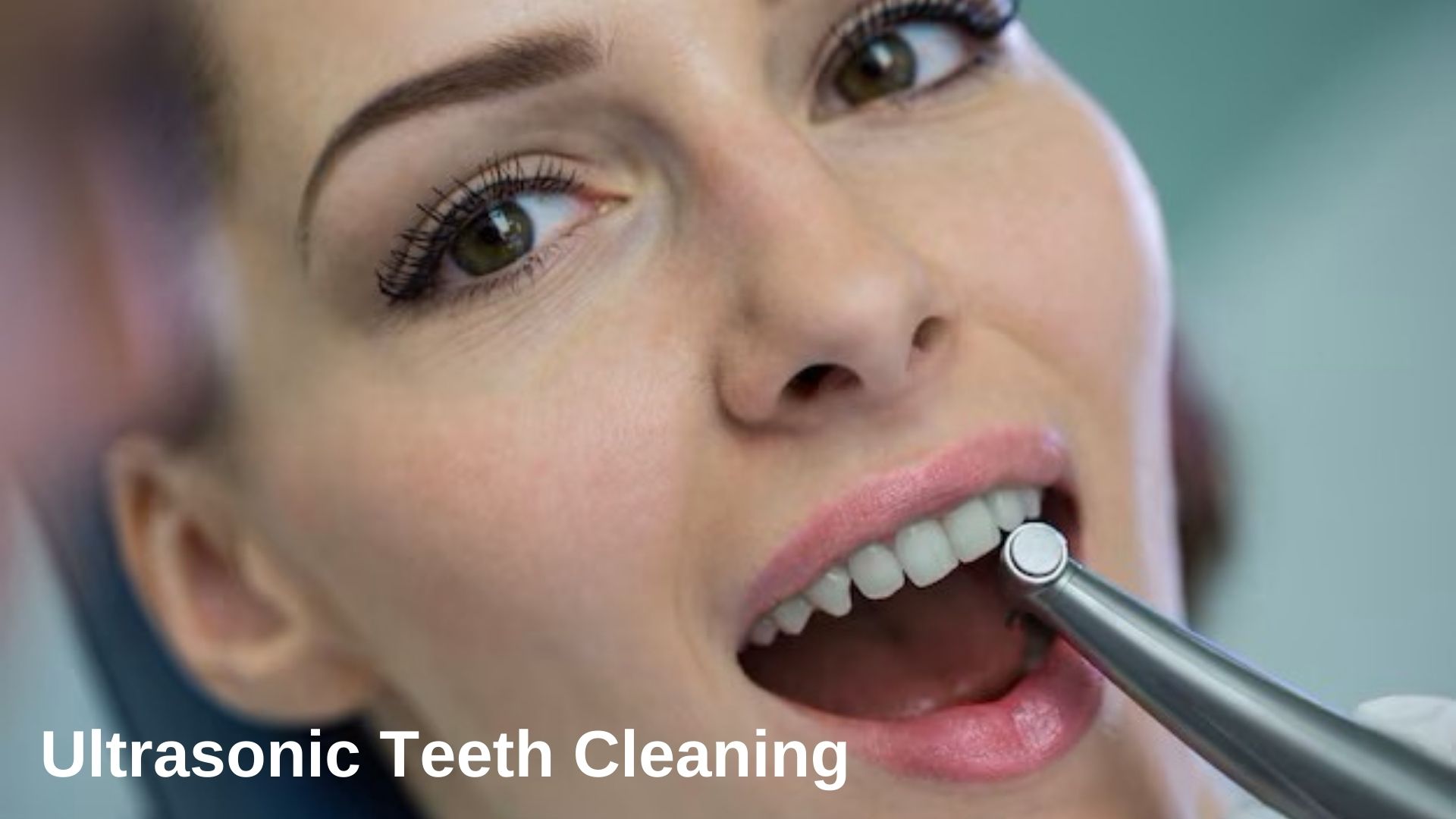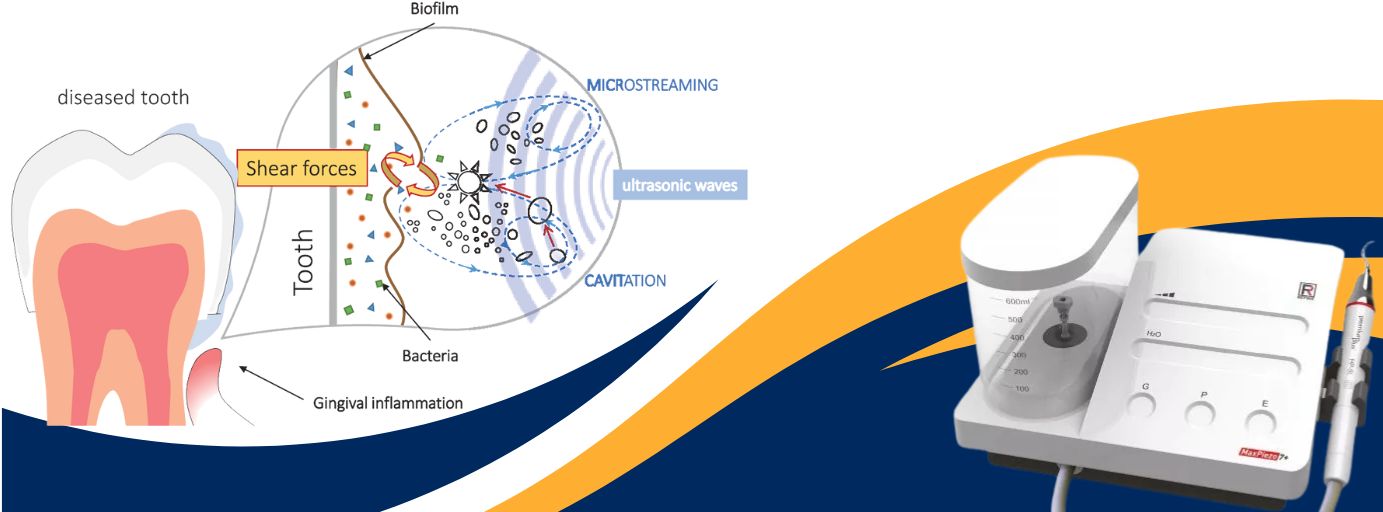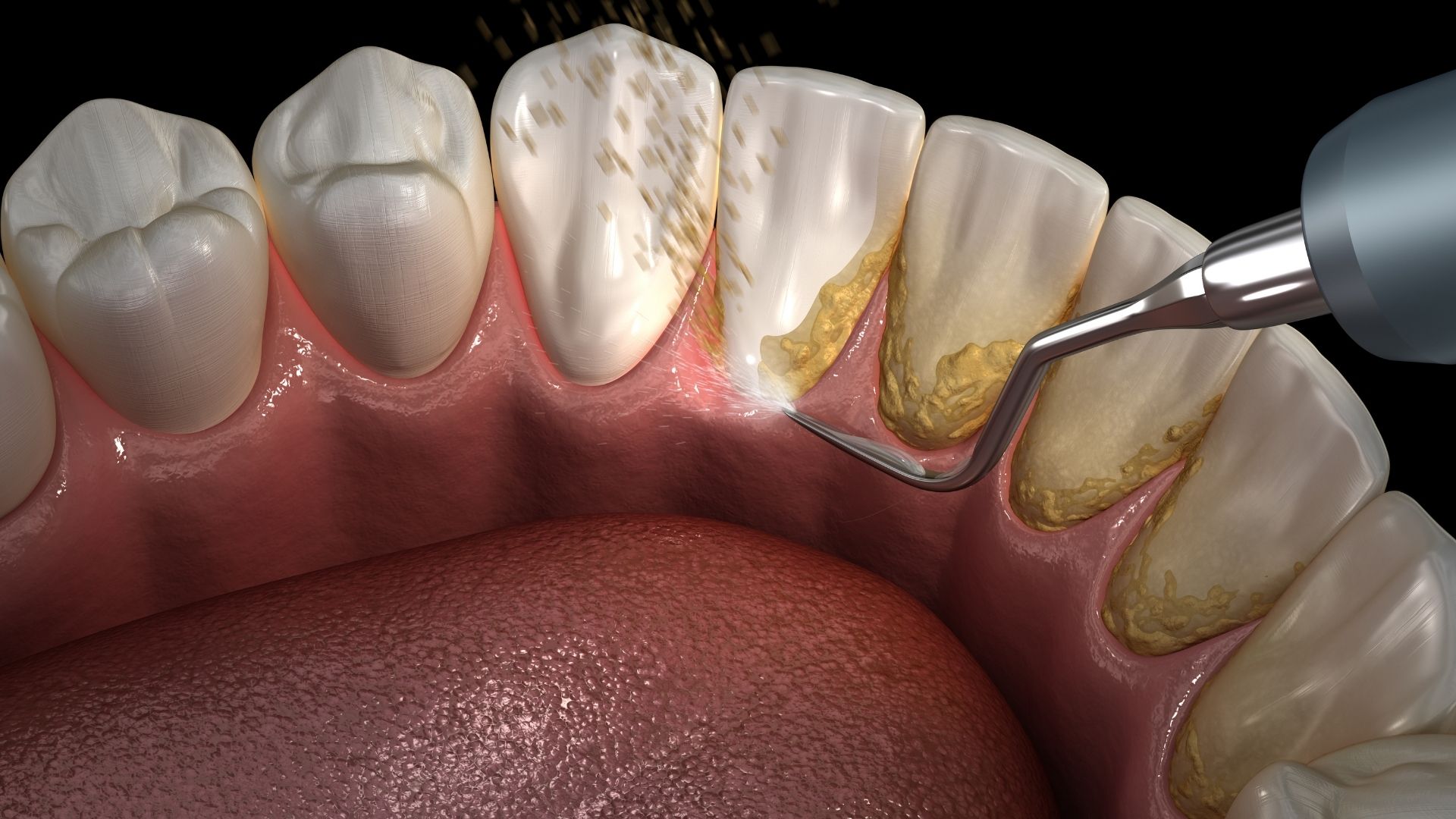What is an ultrasonic tooth cleaning?
Ultrasonic dental cleaning: It is a professional dental cleaning method applied to remove tartar, plaque, and stains on the teeth by using ultrasonic waves vibrating at high frequency. This method is applied with an ultrasonic scaler device and a system consisting of its parts.

How does ultrasonic teeth cleaning work?
The device required for ultrasonic teeth cleaning is an ultrasonic scaler. Ultrasonic scalers work similarly; electromagnetic forces on the handheld wand of the unit cause its small tip to vibrate rapidly. These vibrations, which occur faster than the speed of sound, effectively remove plaque, tartar, and stains from tooth surfaces. At the same time, a stream of water from the tip of the device cools the tip and removes debris from the area being cleaned.

The parts and tasks of an ultrasonic scaler are as follows:
Handpiece (wand):
It allows the tip to vibrate by means of electromagnetic forces. Provides control and guidance of the tip.
Tip:
Removes plaque, tartar, and stains from the tooth surface with high-frequency vibrations. Different tip types are also designed for different tasks. There are special tips for cleaning composite or porcelain dental restorations, titanium implants, or demineralised areas on teeth.
Water supply:
The appliance's water source provides a continuous flow of water to the tip, helping cool it and removing dissolved plaque and tartar deposits. An antibacterial mouthwash solution can also be used in some devices.
Foot pedal:
Controls the operation of the ultrasonic scaler. When pressed lightly, the tip vibrates, and water is sprayed.
Control knobs:
The tip starts to vibrate when the foot pedal is pressed; then, the water control knob is turned to adjust the water flow to cool the handpiece and the tooth. The vibration intensity can be adjusted according to the patient's sensitivity and the hardness of the tartar.
Camera:
Some ultrasonic scaler models are equipped with a high-resolution camera to view the inside of the mouth. These cameras usually come with LED lights and Wi-Fi technology so that the condition of the teeth can be clearly seen.
When should you get an ultrasonic teeth cleaning?
If you have any of the following conditions, you can have ultrasonic teeth cleaning. However, it is important to seek the advice of your dentist to make the best decision.
Calculus, tartar build-up, or tooth stains:
If tartar or calculus has built up significantly on the teeth, ultrasonic cleaning may be beneficial. Ultrasonic cleaning can remove plaque, tartar, and bacteria accumulated in periodontal pockets (areas below the gum line filled with bacteria, tartar, and plaque). It is an effective method to remove long-standing and difficult-to-remove stains, including those caused by coffee and smoking.
Gum disease:
If you are in the early stages of gum disease, ultrasonic cleaning can help stop the progression of gum disease.
Routine teeth cleaning:
You may consider ultrasonic cleaning as part of a routine dental cleaning. Your dentist will assess your oral health and determine the most appropriate cleaning method for you.
Sensitive teeth:
If you have sensitive teeth, ultrasonic cleaning is a gentler option for them.
Restorations and implants:
Porcelain dental restorations, titanium implants, or demineralised areas on teeth are cleaned using special ultrasonic tips.
Bad breath:
Ultrasonic cleaning can help to eliminate bad breath by reducing the build-up of bacteria and plaque on teeth.

Is ultrasonic cleaning good for your teeth?
Your dentist will decide whether ultrasonic cleaning is good for your teeth after examining you in detail. We can summarise the benefits of ultrasonic teeth cleaning as follows:
- Ultrasonic dental cleaners are effective in removing plaque and tartar on the tooth surface. Using high frequency sound waves, it creates microscopic bubbles and these bubbles burst and break tartar and plaque.
- Ultrasonic instruments can penetrate gum pockets better and are more effective at removing tartar below the gum line. This can help prevent and treat gum disease.
- Ultrasonic vibrations reduce the risk of infection by breaking down bacterial cells. In addition, some devices create an oxygenated environment, inhibiting the growth of harmful bacteria.
Is ultrasonic teeth cleaning better?
Before deciding which of the tooth cleaning methods is the best option for you, you should definitely take into account the recommendations of your dentist after the examination. Each tooth-cleaning method has its own advantages and disadvantages. Sometimes, the best results are achieved by combining a traditional dental cleaning method with an ultrasonic dental cleaning method. Ultrasonic instruments remove large tartar deposits quickly and effectively, while manual instruments can be used to remove remaining plaque and smooth the tooth surface. Your dentist will assess your oral health and determine the most appropriate cleaning method or combination for you.
Is ultrasonic teeth cleaning safe?
Ultrasonic teeth cleaning is an effective and safe method with many benefits. Many dentists prefer ultrasonic teeth cleaning over conventional teeth cleaning because it is less invasive and less damaging to tooth enamel. However, there are also some potential risks and side effects.
Do dentists recommend ultrasonic tooth cleaners?
For professional use in dental clinics, dentists recommend ultrasonic teeth cleaning devices. But usually ultrasonic devices used by dentists effectively remove plaque, calculus (tartar), and bacteria from teeth and gums. However, there are some reservations about home ultrasonic teeth cleaning devices.
Ultrasonic teeth cleaning at home:
Dentists do not recommend the use of ultrasonic teeth cleaners at home due to the risks of misuse. The following risks of improper use of ultrasonic teeth cleaners at home may occur:
- Improper use can lead to gum recession.
- Prolonged and incorrect application can erode tooth enamel.
- Bacteria can spread if the device is not sterilised well.
- If used with the wrong technique, the tartar may not be cleaned completely.
Ultrasonic teeth cleaning vs scaling:
A comparative table of ultrasonic dental cleaning and conventional scaling can be found below.
|
Features |
Ultrasonic Teeth Cleaning |
Traditional Scaling |
|
Events |
Ideal for deep cleaning, especially effective in cases of heavy tartar and gum disease. Can reach gum pockets and hard-to-reach areas. |
Suitable for routine maintenance and detailed plaque cleaning. The dental hygienist can remove plaque and tartar by feel, no area is missed. |
|
Speed |
It is faster, taking up more space in less time, which is ideal for busy patients. |
It is slower, but ensures that each tooth is carefully and thoroughly cleaned. |
|
Comfort |
Gentler for patients with sensitive teeth or brackets. Less scraping sensation thanks to high-frequency vibrations. |
It may cause some discomfort due to the scraping action, especially for patients with sensitive gums. |
|
Eligibility |
Ideal for patients with moderate to severe plaque build-up or those who have not had a dental cleaning for a long time. |
It is best for patients who have good oral hygiene habits and require regular cleaning. |
|
Noise level |
It can be noisy due to high-frequency vibrations, which may disturb some patients. |
It is silent, making only slight scraping noises. |
|
Gum Health |
It is extremely effective in removing tartar below the gum line, which is very important for preventing gum disease. |
Cleans thoroughly, but may not reach pockets as deep as ultrasonic cleaning. |
|
Equipments |
Ultrasonic scaler (hand tool with vibrating tip) |
Hand tools (scalers and curettes) |
|
Home Use |
Strongly not recommended, it can damage the gums. |
Not recommended, may damage tooth enamel. |
Ultrasonic teeth cleaning cost in Turkey
Prices for ultrasonic teeth cleaning in Turkey may vary depending on the clinic, the city where the clinic is located, and the extent of the treatment. On average, the price of ultrasonic cleaning for teeth varies between 120 and 150 Euros.
Frequently Asked Questions
Can ultrasonic cleaning damage teeth?
Ultrasonic teeth cleaning is generally a safe procedure and does not damage teeth when properly performed by dentists.
Can cleaning your teeth with ultrasonics traumatise the nerves?
Ultrasonic teeth cleaning usually does not damage nerves and does not traumatise dental nerves when applied correctly. However, in some cases, temporary sensitivity or discomfort may be felt, especially in people with sensitive teeth.
- If there is gum recession, the root surfaces may be more sensitive to ultrasonic vibrations.
- If the enamel is worn away, the underlying dentin layer is exposed, and nerve endings may be more stimulated.
- If there are microscopic cracks, the vibrations can reach the nerve endings and cause short-term sensitivity.
- If cavities are close to the nerve or old fillings are worn away, a slight sensitivity may be felt during the procedure.
How long does it take for ultrasonic teeth cleaning?
The duration of ultrasonic teeth cleaning can vary depending on the amount of tartar on the teeth, plaque buildup, and overall oral health. However, it usually takes between 20 and 60 minutes.
Is ultrasonic teeth cleaning painful?
Ultrasonic tooth cleaning is usually not a painful procedure. However,
- Especially those with gum sensitivity, gum recession, or heavy calculus may experience a slight tingling or stinging sensation during the procedure.
- People with sensitive gums may have mild bleeding, but this is usually normal and heals quickly after the procedure.
Is ultrasonic teeth cleaning safe during pregnancy?
Ultrasonic cleaning carries no risk to mother and baby, as it does not contain chemicals and works only with vibration and water spray. During pregnancy, swelling, bleeding, and inflammation of the gums are common due to hormone changes. Cleaning can help prevent these problems.
Which is better, ultrasonic tooth cleaner or water flosser?
- If you have tartar, use an ultrasonic tooth cleaner.
- If you have gingivitis or sensitivity, water flosser.
- If you have difficulty flossing, water flosser.
- If you have orthodontic braces (brackets), implants, or bridges; a water flosser.
- If you have a chronic tartar problem, an ultrasonic tooth cleaner may be better for you.
As MonarchSmileTurkey dental clinic, we are pleased to achieve results that exceed expectations even in the most difficult dental cases.
For more detailed information, please contact us or visit us at our dental clinic.
